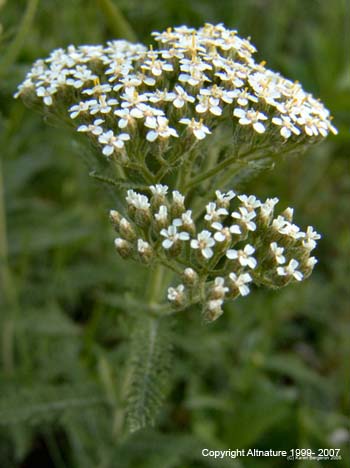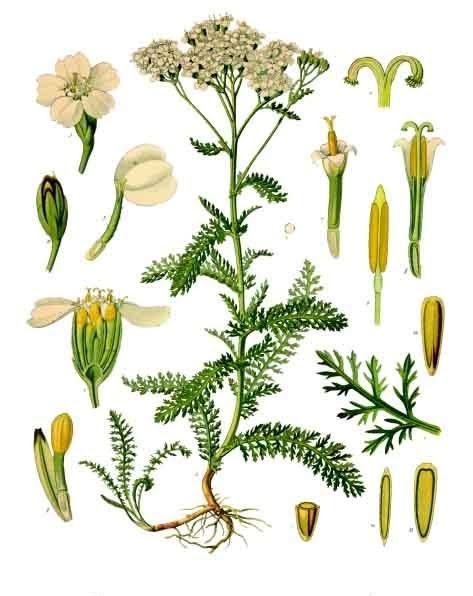The witches corner ...
Witch Craft of the day ..
YARROW

Witches uses yarrow for many purposes.
- If you make a neclace with yarrow in a pouch and hang it over the bed of a new born the yarrow will keep evil witches and sourcerers away.
- You will find abundence of yarrow on cemetaries growing on top of the graves to blame the dead that they did not eat enough yarrow while they were alive.
- If you carry yarrow around your neck you are protected against evil.
Achillea millefolium
The botanic name of yarrow refers to the greek hero Achilleus who used the plant to dress his wounds.
Yarrow is a real female herb.
She can help many female issues and if we just use a bit of yarrow in the food every day we would avoid many of the female un comfortabilities.
Period pains, menapose, migraine cause by hormonel unbalances, cold feet, bad circulation, blowtedness, pressure on the belly etc are just a few of the areas where yarrow can be of use for women.

1 cup tea a day, would keep the trouble away!
Dosage:
Dried herb. 2 – 4 grams , 2 – 3 times a day.
When young and tender, the fresh early spring leaves of Yarrow can be finely chopped and added to salads, soups, meat dishes, stir-fry and cooked beans.
The Haida of the Queen Charlotte Islands dried Butter Clams on Yarrow stalks and then ate the clams directly off the stalks. The stems imparted a pleasant taste to the food.
Mulitiple uses of Yarrow ..
Witches Wisdom:
- The Flathead Indians of Montana rubbed the flower heads in their armpits as a deodorant.
- The Okanagon people placed the leaves on hot coals to make a smudge for repelling mosquitoes (Turner, 1979).
- The Thompson Natives boiled roots and leaves and used the roots for bathing arthritic limbs. The roots were pounded and used as a poultice on the skin for sciatica.
- Root infusions were used to treat colds and venereal diseases.
- The mashed root was placed over a tooth for toothache.
- The whole plant including roots is boiled and the decoction drunk as a tonic or remedy for slight indisposition or general out-of-sorts feeling. This decoction was used as eyewash for sore eyes, and used on chapped or cracked hands, pimples, skin rashes, and insect and snake bites (Turner 1990).
- Annie York, a Thompson Native (B. 1904) noted that, although a very important medicine, for the Thompson, ‘’ it is quite strong’’ AND THE MEDICINE HAS TO BE TAKEN WITH CAUTION. They used Yarrow infusions in small quantities for colds and bladder troubles.
- Yarrow was known as the Soldier’s Woundwort and Herbe Militaris for thousands of years.
They used to pack the yarrow around the wounds as a functional antiseptic and, hemostatic material this latter attribute is especially important in combat where bleeding to death is a constant risk.
This made Yarrow the superior wound dressing, since it stopped bleeding.
It was much preferred to the other materials used to pack deep open wounds resulting from idiotic serious combat, clay, moss.
Sphagnum moss was still used to make antiseptic dressings, spider webs, and horse manure - this one a favorite of the Napoleonic wars during winter and in Russia during the Russian evolution.

MEDICINAL USES OF YARROW
All of the parts of Yarrow are used therapeutically, separately or together, fresh, dried, as teas, poultices, spit poultices, steamed vapours, tinctures, oils, and vinegars.
Harvest on fullmoon where any plants are producing more of its juices than on any other day or night.
Yarrow is an analgesic and antiseptic, so that it stops bleeding, lessens pain, prevents infections, and is often abundant in the open meadows favored particularly by the ancient armies in the Mediterranean wars.
It is also available 12 months of the year in milder temperate zones, particularly in the areas where the surgeon-general Achilles was fighting during the also idiotic Trojan Wars.
Achillea millefolium
The botanic name of yarrow refers to Achilleus who used the plant to dress his wounds.
Witches Warning:
PSYCHOTROPIC YARROW:
The true story ..

Borrowed from a WitchSiSTAR ...
One particularly fine day whilst harvesting Yarrow on a steep talus slope above the sea, I felt suddenly quite giddy.
The feeling resembled benign sunstroke; however, I had been harvesting in complete cliff shade for 3 hours. Involuntarily I sat down and happily laid back into several ancient Yarrow clumps with 3-foot stalks and huge flat umbels 8-10 inches across. Their delicious odors smothered me. As I looked up and all around, all I could see was Yarrow and blue sky. Paradise.
After about 20 minutes I was startled and alarmed to hear my aluminum skiff banging on the rocks far below from the rising tide; harvester’s consciousness cancelled my wonderful Yarrow euphoria.
I wondered what had happened. Was it TIA, dehydration, sunstroke (no sun), Alzheimer’s? Lightheaded, I carefully assembled my harvest bags and slowly descended to my skiff and rowed back to the distal road end.

I mentioned this experience to Brian Wiessbuch, acupuncturist and herbalist. He told me:
“Mark those plants well and harvest them for me next year.
The huge flower size indicates that these Yarrow plants are probably polyploids. Such plants tend to produce much larger amounts of unusual and psychotropic substances than the usual diploid plants.”
Apparently, several hours of harvesting had resulted in significant percutaneous molecular movement of Yarrow-sourced mood and mind-altering substances into my hands and arms.
Similar percutaneous molecular oassage probably occurs during the prolonged handling of Yarrow flower stalks (harvested whilst green with half-ripe flowers on top) during the ritual Yarrow stalk sorting associated with the consultation of the I Ching, a Chinese book of divination.
Accumulation is always followed by dispersal. Yarrow has cleistogamous flowers which are self pollinating and this may encourage polyploidy.

Yarrow hazard:
The pleasant aroma, invigorating bitterness, and mild mood-altering effects of strong Yarrow tea can become habituating.
Ella Birzneck, founder of Dominion Herbal College I Burnaby, British Columbia, warned against drinking Yarrow tea daily for more than two weeks. She did not explain.
Not only can Yarrow infusion become habituating, it may become painfully liver toxic when consumed to excess...
The plants active drugs are among others;
Etheric oils, alcaloids, flavanoids, sesquiterpene, loctones and tanins.
After all of the above, Osol et al (1947) Declare with emphasis in the Dispensatory of the United States of America,’’ there is no scientific evidence of its value’’, referring to medicinal uses of Yarrow.
Similarly, the PDR FOR HERBAL MEDICINES, 1st ED, states that ‘’ Yarrow acts…in a similar fashion to camomile flowers, as their components are partially identical’’.
Those effects include:’’Externally it is used as a partial bath for painful, cramp-like conditions of psychomatic origin in the lower part of the female pelvis, liver disorders, and the healing of wounds.’’ We can only hope for better coverage in subsequent editions.

































